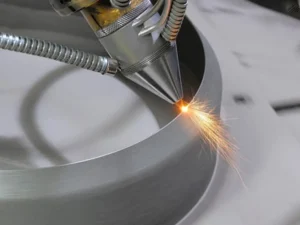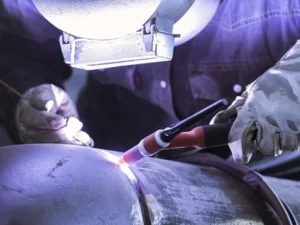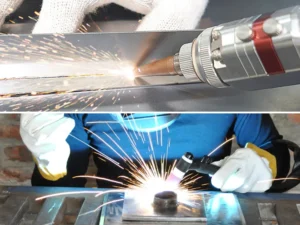Introduction:
Do you want to know the differences between TIG VS laser welding? TIG and laser welding are techniques utilized to join two materials and metals. Although both welding techniques show efficacy, they have unique merits and demerits. This post of laser welding vs tig welding will explore two categories of welders: ARC (TIG) welders and laser welders. We will contrast and compare the two methods and determine what kind of welder is most suitable for you.
What is Laser Welding?

The laser beam melts and fuses the materials at the connection in laser welding. A concentrated and coherent beam of light, a laser beam, produces high temperatures and power.
Types of Laser Welding
Laser welding uses different lasers, including gas, solid-state, and fiber lasers.
Solid-State Lasers
People use solid-state lasers when joining glasses and yttrium aluminum garnet (YAG) materials. You can produce significant spot welds alongside deep spot and seam welds.
Fiber Lasers
Fiber lasers are multipurpose in that they can weld thin and dense materials. Compared to other laser varieties, they are inexpensive while still producing spot welding of high quality.
Gas Lasers
Gas lasers produce concentrated light using a mix of gases like carbon dioxide, helium, or sodium. We use a low-current, high-voltage power source to “excite” the gas mixture. In automotive, keyhole welding operations use gas lasers. It fabricates transmission parts and car bodies.
Modes of Laser Welding
Two distinct modes of laser welding exist heat conduction welding and keyhole welding.
Keyhole Welding
The laser beam goes deep into the metal by heating it until it turns into vapor on the surface. This creates a “keyhole” in which the metal retains a plasma-like state at temperatures higher than 10,000K. You need a laser greater than 105W per millimeter squared to fuse keyholes.
The selected mode will depend on the power density across the beam that strikes the workpiece. Additionally, this aspect will influence how the laser beam interacts with the material having welding.
Heat Conduction Welding
To simplify, we can say: “Heat the metal’s surface without making it completely evaporate. You can achieve this by using a temperature higher than its melting point. A seamless and pristine weld is the result.
Welding applications use heat conduction welding without the need for high weld strength. We use a low-power laser, less than 500W, during heat conduction welding.
What is TIG Welding?

In TIG welding, the welder produces a weld using an electric discharge. TIG represents tungsten inert gas. People used to refer to the components of the welding system.
Connecting the electrode and the workpiece via a tungsten electrode produces an electric discharge. People use argon as an inert gas to protect the arc and weld reservoir from atmospheric contamination. People use a thin wire or filler metal to incorporate substance into the joint.
Types of TIG Welding
TIG welding utilizes three distinct types of arc start: scratch start, lift start, and HF start.
Scratch Start (SC)
Welders apply the scratch start method to welding machines of the transformer variety, which is more traditional.
HF Start
This starting method enables arc formation without manipulating the weld surface with the tungsten. If tungsten contamination of the weld is possible, this may be an essential characteristic.
Lift Start
This is a more frequent occurrence with inverter welding devices. The control circuit senses when the tungsten touches, lifts off the welding surface and starts the arc.
Modes of TIG Welding
TIG welding works in various ways. We group these ways based on understanding how the power supply in the welding machine creates an electric discharge. This discharge occurs between the electrodes and materials. A primary distinction between TIG welding is between direct current and alternating current.
1. Direct Current
Direct current is an electrical current that drives in only one direction. It has a voltage that remains either positive or negative. The current in batteries depicts direct current. Low-voltage devices, including cell phones and remote controls, can detect direct currents.
- Positive Polarity:
A direct current established with a positive electrode leads to greater penetration.
- Negative Polarity:
A negative electrode in DC welding speeds up the process by melting metal faster, leading to deeper deposition rates.
TIG welding is a standard method for all metals except magnetic alloys such as magnesium and aluminum. If a magnetic field interacts with the current during welding, the welding arc may not follow the correct path. This can influence the quality of the weld. The welding arc cannot generate enough heat to overcome the magnetic forces. The welding arc cannot produce enough heat to overcome the magnetic forces.
2. Alternating Current
A voltage that reverses in polarity results from AC, which refers to electricity that changes direction. High-voltage devices, including household appliances and electrical outlets, predict alternating currents.
An alternating current switches direction 60 times per second or at least 120 times every second. Reversed polarity enables extensive penetration welds in TIG welding. Additionally, the arc has no net deflection because its current and magnetic field change direction within a second.
Laser Welding VS TIG Welding: What Is the Difference
Here is the comparison between laser welding VS TIG welding. The following are some examples:

Speed
Laser welding is faster than TIG welding, reaching speeds of several meters per minute. Laser welding is more rapid than TIG welding. It requires greater manual control and skill.
Flexibility
TIG welding is more flexible than laser welding. It can weld different metals and plastics. It can also weld materials with different thicknesses and melting points. TIG welding is also capable of joining difficult-to-reach areas and complex shapes.
Laser welding is less adaptable than TIG welding. It increased the workpiece preparation and alignment required. The materials’ surface conditions, absorption, and thermal conductivity can also impact laser welding.
Quality
Laser welding produces welds of superior quality while eliminating heat-affected zones and distortion. Precision control allows laser welding to make seamless, deep, and narrow welds. TIG welding can also produce welds of superior quality, strength, and aesthetic appeal. TIG welding may result in more heat-affected areas and deformations than laser welding.
Cost
Laser welding is more expensive than TIG welding. It needs special equipment and ongoing maintenance. Furthermore, TIG welding uses less energy than laser welding. Welding with TIG requires less equipment and maintenance, which reduces its cost compared to laser welding. Additionally, TIG welding is more energy-efficient than laser welding.
Automation
In comparing TIG VS laser welding, another main factor difference is automation. Laser welding is better for automation than TIG welding. It works well with robots and other automated systems. This integration allows for improved efficiency and accuracy. Furthermore, a single machine can integrate laser welding with engraving or cutting. Laser welding is more suitable for automation than TIG welding. Moreover, it needs more human intervention and expertise.
Now, you understand the difference between laser VS TIG welding. Let’s dive into both welding method types and modes to see which is better.
Laser Welder VS TIG: Which One Is Better?
Laser welding is a popular choice for manufacturing. It has more advantages over traditional methods like TIG welding. TIG welds create broader and less precise heat-affected zones compared to laser welds. This leads to reduced deformation and distortion in the final product. Moreover, laser welding is more rapid than TIG welding, which can speed up your manufacturing operation.
Precise laser welds constitute an extra benefit. This is because the laser beam can concentrate on the intended area. This lowers the chance of damage to the nearby area. It allows welding to proceed without concern for delicate parts.
Additionally, laser welding applies to a wide range of materials. This includes glass as well as plastics and metals. However, people limit TIG welding to metal. Additionally, it is a rapid procedure.
This results in the potential for decreased production times and cost savings. Additionally, it is finer than alternative techniques because it lacks extra components or gas.
Summarize: Laser Welding VS TIG Welding
TIG and laser welding are two distinct techniques used to join two materials. Although both methods are useful, their merits and demerits are contingent upon the specific context and demands.
Laser welding is faster, better quality, and more automated than TIG welding but is more expensive and less flexible. Laser welding is quicker, better, and less automated than TIG welding, which is cheaper and more flexible.
Thus, the type, thickness of the materials, joint dimensions, shape, operator’s skill, safety, equipment cost, maintenance, speed, and precision of the process all influence the selection of the welding technique. To pick the correct welding method, understand the difference in TIG welding vs laser welding.
